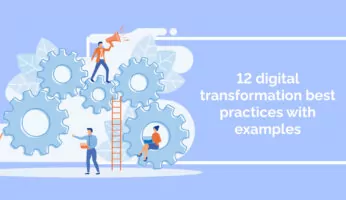
Today, business environment changes are pressuring many organizations to adapt and adopt new operating models. To ensure the success of these new plans, it is important for HR and IT to partner up and build a plan that boosts both employee and organizational agility.
Adapting to Business Changes: A Guide for HR and IT
While digital innovation has spurred massive growth across multiple industries, it has also caused a digital divide within the workforce.
According to research from PwC, for instance, a number of CEOs are worried about the availability of key skills. The growing skills gap, they suggest, is also causing a gap between organizational goals and employees’ ability to meet those goals.
To close this gap and ensure organizations can stay agile, HR and IT need to rethink their role in the organization, adopt new workforce training strategies, foster innovation, and more.
Below, we’ll look at some of the key initiatives HR and IT should embark upon together in order to facilitate these types of changes:
1. Implement an upskilling program
Employee training is the best way to close the digital skills gap.
In the digital workplace, though, traditional types of training are not the answer. Classroom-based training, for instance, is too slow, costly, and ineffective for modern enterprise training needs.
Instead, employers should look to modern training solutions, such as digital adoption platforms (DAPs). These types of platform offer micro-training – also known as just-in-time training – that provides in-app guidance at the moment of need.
These types of solutions can be rapidly adapted to any work environment and any set of tools, then continually adjusted by training managers as needed.
When implementing such tools, HR can orchestrate their integration within the workplace, while IT can assist with the logistical and technical side of deployment, tech stack integration, and related operational tasks.
2. Modernize employees’ workflows
HR and IT should also work together to adopt next-gen workflows that exploit data, automation, digital technology, and new business methodologies.
Yet when making such changes, HR and IT should be careful to minimize complexity.
As new tools are adopted, after all, workflows become more complex. If that complexity is left unchecked, those workflows can quickly become unmanageable.
However, DAPs, mentioned above, can be used to minimize that complexity, simplify workflows, reduce software-related frustration, and ultimately improve employee performance.
3. Transform HR
An HR transformation can include all of the points mentioned earlier, such as learning new tools, workflows, and skills.
By embarking on its own digital transformation journey, HR can obtain many of the same benefits covered earlier.
A few specific actions to take include:
- Adopting HR software to increase productivity, performance, and efficiency
- Using HR analytics to improve insights and decision-making within every area of HR, from the employee experience to HR workflows
- Redesigning business processes around digital technology
- Hiring digitally savvy HR staff and bringing HR workers up to speed on digital-first workflows
In short, HR should become a digitally mature department.
As with the other points covered in this post, this will require that HR draw upon the expertise of the IT department.
4. HR should support IT’s new role in business
The new business world is bringing about changes to organizational structures, business models, and operating models – all of which place new responsibilities on IT teams.
For example, IT is becoming increasingly central in many companies. CIOs and their teams are no longer simply being viewed as back-office functions, they are now pivotal to key business activities, such as product development, the customer experience, business agility, and more.
Yet this shift in responsibilities presents challenges:
- IT staff are being overloaded with more and more responsibilities
- CIOs are being asked to perform tasks above and beyond IT operations, such as leading digital transformation initiatives or strategic workforce planning
- The digital skills shortage is affecting not only the core workforce, but it is also becoming more difficult to find talented IT workers
These looming obstacles present even more reasons why IT should work closely with HR – HR has the ability to keep the workplace staffed with talented IT workers.
Also, by increasing the overall digital savviness of the workforce, as mentioned above, IT teams can begin offloading certain operational tasks to employees.
Final Thoughts
The transformation of HR and IT are really just part of the larger digital transformation of the organization. Technology-driven innovation has fueled changes to every aspect of the business, from strategy to the employee experience.
HR and IT, however, play a very important role in the process, as we have seen.
After all:
- HR manages the workforce, and the workforce powers the business, so employees must be engaged, productive, and skilled
- IT is in charge of digital technology, which has become the central pillar of many organization’s strategic efforts
- When both departments work together, they can accelerate digital innovation, improve business outcomes, enable workforce agility, and much more
Following the guidelines covered here is an excellent place to start. For more ideas on where to go next, check out these articles on the new CIO and HR transformation.
WalkMe Team
WalkMe spearheaded the Digital Adoption Platform (DAP) for associations to use the maximum capacity of their advanced resources. Utilizing man-made consciousness, AI, and context-oriented direction, WalkMe adds a powerful UI layer to raise the computerized proficiency, everything being equal.



